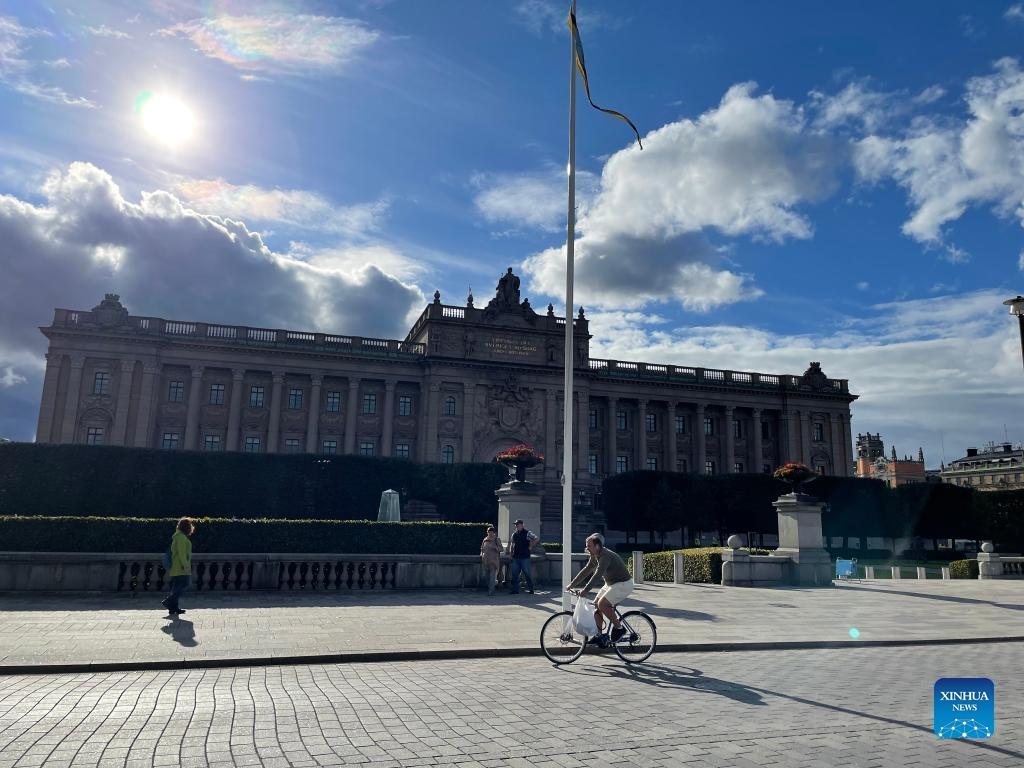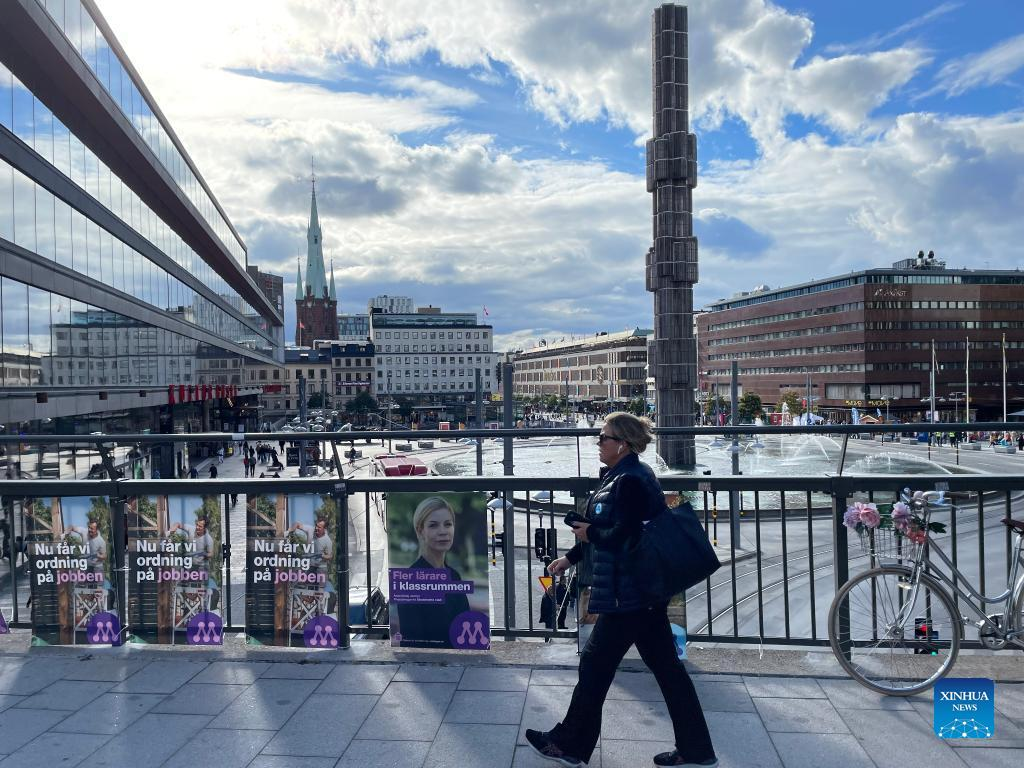News Analysis: Sweden braces for tight general election

Photo taken on Sept. 7, 2022 shows Swedish Parliament building in Stockholm, Sweden. (Xinhua/Fu Yiming)
STOCKHOLM, Sept. 8 (Xinhua) -- People in Sweden will go to the polls on Sept. 11 to elect a new Parliament (Riksdag) against the backdrop of a spiraling energy crisis, surging crime and the ongoing debate about the country's bid to join the North Atlantic Treaty Organization (NATO).
The anti-immigration, far-right Sweden Democrats are now the second largest party in the polls, far ahead of the liberal-conservative Moderate Party. Regardless of their eventual political weight, the Sweden Democrats have already managed to shift the country's entire political spectrum to the right, further complicating the formation of a new government.
FAR-RIGHT LIKELY TO BECOME KINGMAKER
A poll conducted by the Swedish opinion and social research company Sifo and published on Wednesday gave the Sweden Democrats 21 percent against the Social Democrats' 30.1 percent and the Moderate Party's 17 percent. The Social Democrats have come first in every Swedish election for over a century.
Between 2010 and 2022, the percentage of those voters who would not choose the Sweden Democrats dropped from 79 percent to 55 percent.
In the 2010 general election, the far-right party burst into Parliament, securing 5.7 percent of the vote. In 2014, it won 13 percent, making it the country's third largest party. Then, in 2018, support for the Sweden Democrats continued to build, helping the party become the third largest in Parliament.
For years, Sweden had two major political blocs. The center-left bloc brought together the Social Democratic Party, the Left Party and the Green Party, while the center-right bloc included the Moderate Party, the Christian Democrats, the Liberal Party and the Centre Party.
Should the Sweden Democrats emerge as the second largest party on Sunday, the country's traditional political map would doubtlessly be redrawn.
Sifo's poll shows that the margin of support between the red-alliance -- the Social Democratic Party, the Left Party, the Green Party, and the Centre Party, and the opposing blue-alliance -- the Moderate Party, the Christian Democrats, the Liberal Party and the Sweden Democrats has narrowed to less than one percent from five percent even a few months ago.
Driving this change are the Sweden Democrats, Toivo Sjoren, opinions chief at Sifo, told reporters at a press briefing on Wednesday.
ENERGY CRISIS HIGH ON AGENDA
Citing the soaring energy prices and the record-high inflation, the ruling Social Democratic Party and the major opposition Moderate Party have recently called on the country's public sector employees to reduce electricity consumption and save energy while ensuring basic operations.
Prime Minister Magdalena Andersson said recently that the European electricity market was seriously out of balance, and that her government had proposed to decouple over-priced gas from electricity prices to provide energy security to the country's households and companies. She said that the EU member states should create a broad alliance and work together to lower electricity prices.
Similar calls and pledges have also been heard from the opposition parties. Ulf Kristersson, leader of the Moderate Party, said that the blue-alliance was likewise ready to offer financial support to the country's households and businesses already before the end of this year.
To this end, the current opposition parties want the Swedish power grid to develop a capped price model as soon as possible. Certain analysts, however, question this tight timeframe.
The findings of the Sifo poll also revealed that, just days before the general election, the future looks rather bleak for the Swedish public. In August, the percentage of those who considered themselves optimistic about the future declined from around 60 percent to around 40 percent, while the ratio of pessimists increased from around 30 percent to 40 percent.
The top three issues discussed in the local media in August were law and order, the environment and energy, and migration/integration. Remarkably, the economy, the labor market and business policy were relegated to the back seat.
OUTCOME UNCERTAIN
For now, the election's outcome remains anyone's guess.
Andersson may well keep her job, although at this point the conflicts within the red-alliance appear highly irreconcilable, especially on economic policies, Josefina Erikson, associate professor in the Department of Government at Uppsala University told Xinhua on Wednesday.
Political commentator Mats Knutson told Swedish Television recently that forming a new government would be a very tough task, and even if the Andersson-led Social Democrats won it would still be "a nightmare" for her to form a government this autumn. Even the need for a new election cannot be excluded.
As the far-right Sweden Democrats become the second largest party, it would have "substantial influence on the government policies it already has," Erikson told Xinhua.
On the other hand, even if the red-alliance wins, it is still difficult to form a new government, as the Left Party, also a member of the current red-alliance, could withdraw support to the prime minister if it disagrees with government policies, she explained. ■

Photo taken on Sept. 7, 2022 shows Swedish Parliament building in Stockholm, Sweden. (Xinhua/Fu Yiming)

A woman walks past election campaign posters in Stockholm, Sweden, on Sept. 7, 2022. (Xinhua/Fu Yiming)

People walk past election campaign posters in Stockholm, Sweden, on Sept. 7, 2022. (Xinhua/Fu Yiming)

People walk past election campaign posters in Stockholm, Sweden, on Sept. 7, 2022. (Xinhua/Fu Yiming)

A woman walks past election campaign posters in Stockholm, Sweden, on Sept. 7, 2022. (Xinhua/Fu Yiming)
Photos
Copyright © 2022 People's Daily Online. All Rights Reserved.









